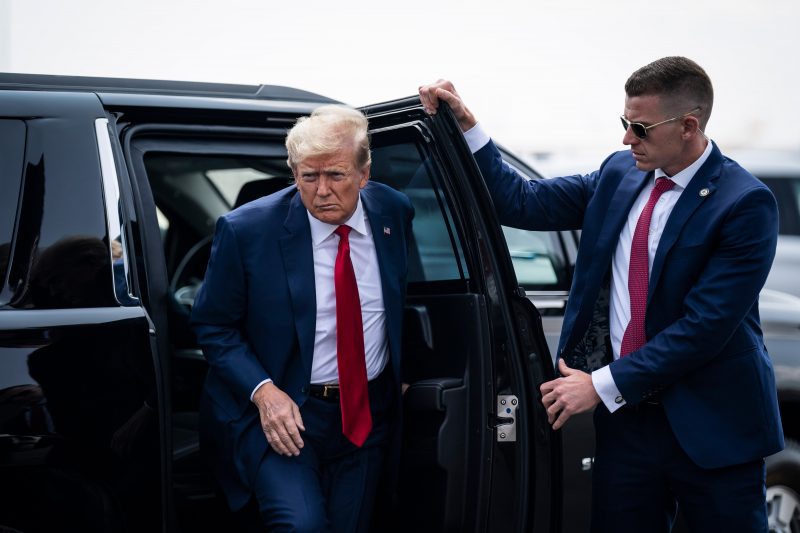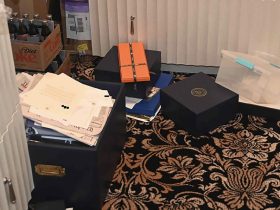During his four years in the White House, Donald Trump routinely flouted the laws, rules and conventions that govern the handling of classified information.
He tweeted a photo of an Iranian missile launch site, which revealed the capabilities of U.S. spy satellites. He tipped off the Russians to a foreign ally’s source inside a terrorist organization, potentially putting the life of an agent at risk. He took transcripts of his calls with foreign leaders as well as photos and charts used in his intelligence briefings to his private residence with no explanation, and aides sometimes lost track of the sensitive documents.
The way President Donald Trump handled classified information, which some of his own advisers considered reckless, was his official prerogative. Now, as a private citizen, it’s allegedly a crime.
“As president, Trump had lawful access to the most sensitive classified documents and national defense information gathered and owned by the United States government,” a federal indictment unsealed Friday states in its opening sentences. “At 12:00 PM on January 20, 2021, Trump ceased to be president” and was no longer “authorized to possess or retain those classified documents.”
The 37 counts against Trump, the first former president to face federal criminal charges, describe a man who seemed not to recognize or care about the bright legal line that separates the presidency from life after it. According to the indictment, the documents in Trump’s possession were either originated by or implicated the interests of every major intelligence agency. They cover the entire gamut of U.S. spying capabilities, including information acquired by electronic surveillance, satellite reconnaissance and human spies.
Other former government employees who have been found guilty of “willful retention of national defense information,” under the same provision of the Espionage Act with which Trump is charged, have been sentenced to years in prison.
In some ways, the historic moment where Trump finds himself now was predictable, say former officials who worked for him and experts that observed his behavior. As president, Trump chafed against procedures designed to protect secrets that he saw as restraints on his authority, enforced by an intelligence bureaucracy that he held in deep suspicion.
Photographs included in the indictment shows dozens of cardboard boxes stashed at Trump’s Mar-a-Lago estate — here stacked on a ballroom stage, there crammed into a bathroom. Their sides bulge and their tops wobble. In one photo, a box has fallen to the floor of a storage closet, spilling classified documents for anyone to see.
The special counsel investigating Trump alleges that he stored those documents and hundreds more alongside old newspapers, press clippings, letters, notes and cards. That idiosyncratic filing system was not unique to Trump’s post-presidency. Aides and advisers say it is how he handled the government’s most highly-guarded secrets while he was in office, carting them from room to room at the White House in flimsy bankers boxes.
In an interview last year, a longtime adviser called Trump a “pack rat” and a “hoarder.” Several former aides said that Trump tried to intimidate anyone who attempted to retrieve secret documents after a meeting or keep them out of his hands.
“I can’t say what went wrong that resulted in some boxes ending up at Mar-a-Lago,” said a former official who knew that Trump took classified information to his personal White House quarters, and asked to speak on the condition of anonymity to discuss sensitive matters. “But you can see that as an extension of four years of accommodating the president.”
It’s also an extension of the low regard in which Trump held the agencies that collected the intelligence, which he nevertheless coveted.
From practically the moment he took office, Trump saw himself at war with the intelligence community’s leadership. On Jan. 21, 2017, his first full day as president, he stood in the marble lobby of the CIA headquarters in Langley, Va., in front of a wall of stars that honors officers who died in the line of duty, and exaggerated the size of the crowd that had attended his inauguration.
“There is nobody that feels stronger about the intelligence community and the CIA than Donald Trump,” he declared. In one respect, that was true. Trump felt so strongly that, 10 days earlier, he had compared the intelligence agencies to “Nazi Germany” and claimed they had engineered the release of a political opposition research document filled with allegations about his private life and connections to Russia.
Trump fixated on the heads of the CIA and FBI as ringleaders of a “Deep State” conspiracy trying to trash his reputation and sink his presidency. He would spend the next four years lambasting intelligence officials in tweets and firing or sidelining them when they refused to bend to his will.
“I’ve never met anyone who was more sure that he was right on every topic,” Sue Gordon, a career intelligence officer who served as the principal deputy director of national intelligence from 2017 to 2019, said in an interview. “I’ve tried not to assume motivation. But clearly he did not recognize the authority of the system. And that’s a problem, because the system was playing as though he was part of it, not an individual making his own rules.”
Trump never hid his disdain for the officials who advised him. In testimony to Congress in January 2019, the directors of the FBI and the CIA, along with the director of national intelligence and other senior officials revealed significant differences between what the intelligence community had concluded and what Trump often claimed about a range of urgent national security topics, including Iran’s potential pursuit of nuclear weapons.
“The Intelligence people seem to be extremely passive and naive when it comes to the dangers of Iran. They are wrong!” Trump wrote on Twitter. “ … They are testing Rockets (last week) and more, and are coming very close to the edge. There economy is now crashing, which is the only thing holding them back. Be careful of Iran.”
He added: “Perhaps Intelligence should go back to school!”
Trump’s attack on his advisers was also aimed at his predecessor, who had negotiated the Iran nuclear deal that Trump long opposed and ultimately abandoned.
“He doesn’t like the deal because Obama made it,” one U.S. official said at the time.
Trump’s objective in ridiculing his intelligence leaders had less to do with the substance of their conclusions than it did with undermining public confidence in the agencies themselves as neutral purveyors of information, the official said.
For Trump, intelligence was not merely a tool to help the president make decisions. It was political ammunition. And it was personal.
“Trump’s behavior as president was consistent with his conduct as a businessman. He was always jostling for maximum advantage, violating norms, and claiming victimhood,” said Steven Aftergood, an expert on government secrecy with the Federation of American Scientists. “He rarely displayed a sense of honor or scruple, and often scorned those who did. It was poor leadership, and now it may prove to be criminal misconduct.”
Intelligence also served to inflate Trump’s ego. In May 2017, Trump boasted to two top Russian officials about a valuable stream of intelligence the United States was receiving from Israel about an Islamic State terrorist threat related to the use of laptop computers on aircraft. Trump seemed to brag about his knowledge of the looming threat. “I get great intel. I have people brief me on great intel every day,” the president said, according to an official with knowledge of the exchange. The Post first reported the conversation, which took place in the Oval Office with Russian Foreign Minister Sergei Lavrov and then-Ambassador Sergey Kislyak.
“This is code-word information,” a U.S. official said at the time, using terminology that refers to one of the highest classification levels used by the intelligence agencies. Trump “revealed more information to the Russian ambassador than we have shared with our own allies.”
If almost anyone else in the government had shared the information, they’d face criminal charges. But as president, Trump was legally entitled to give it to whomever he wanted, despite the grave risks his own aides said that posed.
Trump did not identify Israel by name, according to people familiar with the conversation, but he provided enough specific details that officials feared the Russians could easily deduce the country that was providing the information and potentially how they had acquired it.
The Post did not report the name of the country. A senior U.S. intelligence official, appointed by Trump, later called reporters at another news organization who had learned Israel was the source and asked them not to publish it. Doing so, the official said, posed “a credible threat to life,” suggesting that Israel had a human spy with access to the inner workings of the terrorist group.
At the time of the Oval Office meeting with Russian officials, Trump was already under fire for mishandling classified documents, including at Mar-a-Lago. One Saturday night in February 2017, after North Korea conducted a surprise ballistic missile test, Trump sat at the dinner table on his patio with Japanese Prime Minister Shinzo Abe discussing their response. The leaders reviewed sensitive documents by the light of a cellphone. Trump could have retired to a secure location set up at the resort to formulate a plan, but instead he turned his club into an open-air Situation Room, where dinner guests snapped pictures of the two leaders that they posted to social media.
Trump seemed to delight in his ability to instantly declassify information by tweet. In August 2019, he shared a photo of an Iranian missile launch site, which appeared to have had been captured by a satellite. Trump said it showed a “catastrophic accident during final launch preparations for the Safir SLV Launch at Semnan Launch Site One in Iran.” The Safir is an Iranian rocket used to place satellites in orbit.
Trump seemed motivated by his desire to taunt Tehran for the explosion, noting “the United States of America was not involved.”
“I wish Iran best wishes and good luck in determining what happened at Site One,” Trump wrote.
Within hours, online sleuths figured out that the satellite was run by the National Reconnaissance Office, which operates a fleet of the United States’ most sophisticated space-based spying platforms. The image itself revealed technical capabilities, experts said — elements of intelligence gathering that classification rules are designed to protect.
Later that evening, Trump defended his actions to reporters. “We had a photo and I released it, which I had the absolute right to do, and we’ll see what happens,” he said.
Since the FBI raided Mar-a-Lago last August, Trump has insisted that he had a right to keep classified information at his home. He has advanced the theory, with no evidence, that he may have declassified information while in office, even without telling anyone, and has suggested that this freed him to take boxes stuffed with secrets to Florida.
But private recordings made after Trump left office, which are described in the indictment, suggest that he knew the documents in his possession contained information he legally could not possess, make public or share.
In July 2021, Trump allegedly gave visitors to his Bedminster golf club a peek at documents that appeared to describe potential U.S. military options for attacking Iran. “This is secret information,” Trump said, according to the indictment. “See as president I could have declassified it. Now I can’t, you know, but this is still a secret.”
In sharing the classified information, Trump looks to have been trying to settle an argument. Trump’s guests were working on a book about his former White House chief of staff, Mark Meadows, which would cover a period of heightened tensions between the United States and Iran. Gen. Mark A. Milley, the chairman of the Joint Chiefs of Staff, had reportedly said that Trump was eager to attack the country. But the idea was really Milley’s, Trump said, pointing to classified documents as proof.
“Look what I found, this was [Milley’s] plan of attack, read it,” Trump said, according to the indictment, which identifies the general as a “senior military official.”
“Isn’t it amazing? I have a big pile of papers, this thing just came up. Look. This was him. … This totally wins my case, you know.”
In his only public remarks about the indictment, special counsel Jack Smith left no doubt how he viewed the stakes of the case against the former president.
“Our laws that protect national defense information are critical to the safety and security of the United States and they must be enforced. Violations of those laws put our country at risk,” Smith said at a brief appearance before reporters on Friday. “We have one set of laws in this country, and they apply to everyone.”
In a video statement, Trump called the allegations a “boxes hoax,” and said he was “an innocent man.”
“This is warfare for the law, and we can’t let it happen,” he said, repeating a list of political grievances that he railed against while in office and that have become a staple of his reelection campaign.
“In his own mind, Trump has never left the presidency,” said Timothy Naftali, a presidential historian and national security expert who ran the Richard M. Nixon Presidential Library and Museum. “Our system depends on the commander in chief understanding that their power is a limited privilege, and that when their term ends, that power transfers to the next occupant of the office. It’s a threat to the republic to have former presidents who believe their power is a lifetime privilege.”








